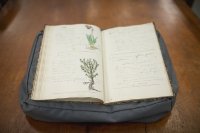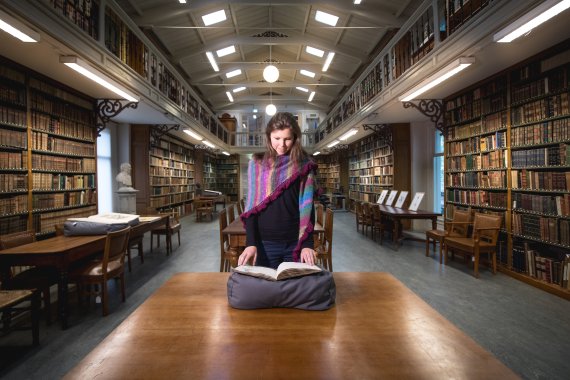Biology student Ingeborg Swart investigated a book of herbs around 200 years old that is in the Artis library.Photo: Sven Menschel
The safe in the library of Artis Zoo in Amsterdam contains a flat cardboard box. In that box is a book, A4 size, with exquisite hand-coloured drawings of flowers and plants. The illustrations have been glued in carefully and are accompanied by hand-written texts. At first glance it appears to be a kind of catalogue.
Artis curator Hans Mulder had the book brought up to the library especially for the Resource photo session as the catacombs of the Artis library are strictly forbidden territory. Even Master’s student Ingeborg Swart has never been there. But there is plenty to enjoy in the library itself. It’s like walking into a Harry Potter film. Thousands of brown, leather-bound volumes cover the walls. Scholarship from days gone by. The only painting in the room is of a stern-looking Carl Linnaeus.
Who was the author?
‘Isn’t this fantastic!’ Swart’s eyes sparkle at the sight of this treasure-trove. She ‘really loves’ books. ‘I wanted something different from your average ecology internship. I wanted to do something with biology and communication.’ She contacted the Naturalis museum, which was convenient as Tinde van Andel, who works at Naturalis and is also professor by special appointment in Ethnobiology at Wageningen, had just come across something interesting: an old, forgotten, mysterious book of plants in Amsterdam.
Corpora ex Regno Vegetabili of Ligchaamen uijt het Plantenrijk, it says in flamboyant letters on the cover (which translates as ‘bodies from the kingdom of plants’). That’s all. No author, no town, no date. The book contains 271 descriptions of plants, with hand-coloured drawings added of 136 plants. Swart was given the job of identifying the plants and finding out who the author was.
To start with the second task: she wasn’t able to discover who wrote it. Swart thinks the author must have been a dealer in medicinal plants and that he produced the book in around 1800. She arrived at that date based on the watermark in the paper. Swart drew her conclusion about the profession of the man (or woman, but that is less likely) because of aspects of the texts. But the author is still unknown.
Detective work
It was a bit like CSI, only with books. She started by taking photos of every page in the Artis library, perched on a stool and using a borrowed camera. The book itself is too fragile to work with. Then she read the book, converting the old-fashioned language into modern Dutch and eventually translating it into English. That was the easy part.
The real detective work was in finding the names of the various plants. Swart says, ‘That took a lot of effort. A Dutch name and two semi-scientific names were given for most of the plants. The author didn’t use the Linnaeus classification, which is the standard these days. That made it difficult to find the Dutch names for the exotic plants in particular.’ Swart spent a lot of time in the Naturalis Herbarium in Leiden tracking down similar illustrations and descriptions in old reference books from that period. ‘Really fun detective work.’
Cornflower
Incidentally, the illustrations in the manuscript are not original. The author has cut them out of a known standard work from 1549 by the German botanist Leonhard Fuchs. So the author was clearly affluent as such books were expensive. According to Swart, he must have cut the illustrations from two copies. He also made quite a few mistakes: some illustrations did not end up with the right descriptions. A good example is the cornflower on page 47, which he has confused with the poppy.
This makes Swart think he can’t have been a botanist or biologist. That is also clear from the descriptions of the plants, which are more about their provenance and how to recognize them than their botanical characteristics. And given the lack of detailed information on their medicinal applications, her supervisor Van Andel does not think the author was a pharmacist either. ‘It doesn’t contain any recipes for medicines. But the author does give very precise information about what a good quality plant should look like and he knows exactly where the exotic plants come from and where the native plants grow.’

Trade in herbs
Artis was given the Corpora in 1860 by someone called J.F. Steenbergen. It is not clear at present who that was. ‘I’ve never actually seen a book like this before,’ says Van Andel. ‘It’s a manuscript, so it wasn’t published. Books like this often spend ages on a shelf with other unknown manuscripts in historical libraries. They end up there when a house is cleared, for example. Artis asked me whether I wanted to do some research on it.’
Even if the man who produced it really was a dealer in medicinal herbs, that still leaves lots of options because there were hundreds of such dealers in Amsterdam back then, says Van Andel. ‘The medicines in pharmacies consisted primarily of plant extracts, which were kept in convenient quantities in stoppered bottles. The pharmacists bought the plants off dealers, who in turn purchased them from growers. The exotic plants arrived by ship in the ports.’ The Utrecht researcher Wouter Klein hopes to get a PhD soon for his study of the trade in medicinal herbs between 1650 and 1800. He will also do more research on the possible sources for the text in the Corpora.
Back in the safe
Swart’s work on the case has now finished. The legacy of her internship is the website plantenrijk.wordpress.com, where you can read the entire book; finally, the book has been made public after over 200 years. Van Andel hopes this will lead to more such books turning up. The Corpora itself has now been returned to its cardboard box in the Artis safe.

